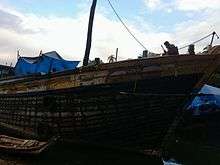Khalasi
Khalasis are a group of people traditionally employed at ports and dockyards. Khalasi is an Arabic word which means dockyard worker, sailor, lascar etc. Khalasis are concentrated at Beypore and nearby areas in Kozhikode district in Kerala, India. Traditional job profile of Khalasis focus on drawing the ships and boats on shore for maintenance and repair and also pushing the same back to the sea. No machinery was employed for the purpose. Dabber (daver), slenky, ropes and pulley were the only tools used. The Khalasis mainly relied on physical strength, skill and teamwork. Many of them are skilled divers. Many families at Beypore and Chaliam are employed in this work for generations. Majority of Khalasis are Muslims and Khalasis are sometimes called Mappila Khalasis. Khalasis work under a leader called Mooppan. Khalasis are employed at Cochin and Visakhapatnam ports. The services of Khalasis were utilized by the Railways for retrieving the bodies from the water in the Peruman Rail Accident (July 1988).

History
Khalasis have a history dating back to over 2000 years. Derived from the Arabic word Khalas meaning release, the word Khalasi is now used both in Malayalam and in Hindi, to refer to anyone who releases a ship or boat into the water. The Khalasis of Malabar engaged in boat building and boat repair use simple but cleverly designed equipment and devices put together by ancestors that leverage muscular strength quite amazingly. Though education is hardly their strength, what they have in abundance is a natural wisdom and simple commonsense. Deceptively simple wooden winches called davars and long wooden handles called kazhas work wonders as winches, and a network of steel wires and thick coir ropes transmit torque and rotation as smoothly as any high-end machinery. Traditionally the domain of Moplah Muslims, Hindus and even Christians have since joined the cadres of this exclusive band of muscular, energetic men who trace their lineage a long way into the past.History Of Beypore Beypore was a center of overseas commerce since ancient times. It was also a center of shipbuilding industry. Kerala had an abundant supply of wood and skilled labor which was utilized for ship building. Francis Buchanan has made a reference about the ships built at Bepore which were used for military purposes.
Khalasis are a group of people traditionally involved in the construction of Urus. They are also used to draw the Urus ashore for maintenance and repair and also pushing the same back to the sea. The word Khalasi in Arabic means a dockyard worker, sailor or lascar. A member of the Muslim community in Kerala is generally known as Mappila. Since majority of the Khalasis are Muslims they came to be called a Mappila Khalasis. Beypore being an exclusive timber outlet of Kerala has been a fascination for many seafaring people, especially the Arabs. They were mainly into ship building and slowly a ship building industry developed in Beypore. Their main constructions were the Arab trading dhows (Arabic name for Uru). As the industry flourished, the demand for skilled laborers to move these ships to and from the sea increased, which in turn resulted in the rise of the Khalasis. There are many families in Beypore and Chaliam in the Kozhikode district of Kerala, who have been working as Khalasis for generations. The skills of the Khalasi community have amazed the sailors and merchants from European and Mediterranean countries, which brought them to Beypore to buy Urus. The native technique employed by Khalasis for their work is based on the principle of pulleys. The equipment consists of wooden rails, rollers and ropes. The wooden pole is moulded as windlass and pulleys and hawsers are used for leverage. As the Khalasis exert pressure on the handles with the accompaniment of their traditional work songs that fill the entire atmosphere with vigour and vitality the huge mass; be it a ship or a heavy wooden plank, moves with ease to the amusement of the watching it. Not just ships, the Idukki dam, Feroke Bridge, Vadakkumbadu Bridge and the Mahanadi Bridge in Orissa; all these huge constructions stand testimony to the amazing skills and teamwork of the Khalasi people. Their skill also had been utilised for building the huge clock in the makkah royal clock tower which possesses the world record of tallest and largest clock in the world. The incredible skill of Khalasis was also used to winch out the bogies during some of the major train accidents in India.Khalasis of Beypore and Chaliam of Kozhikode dist.